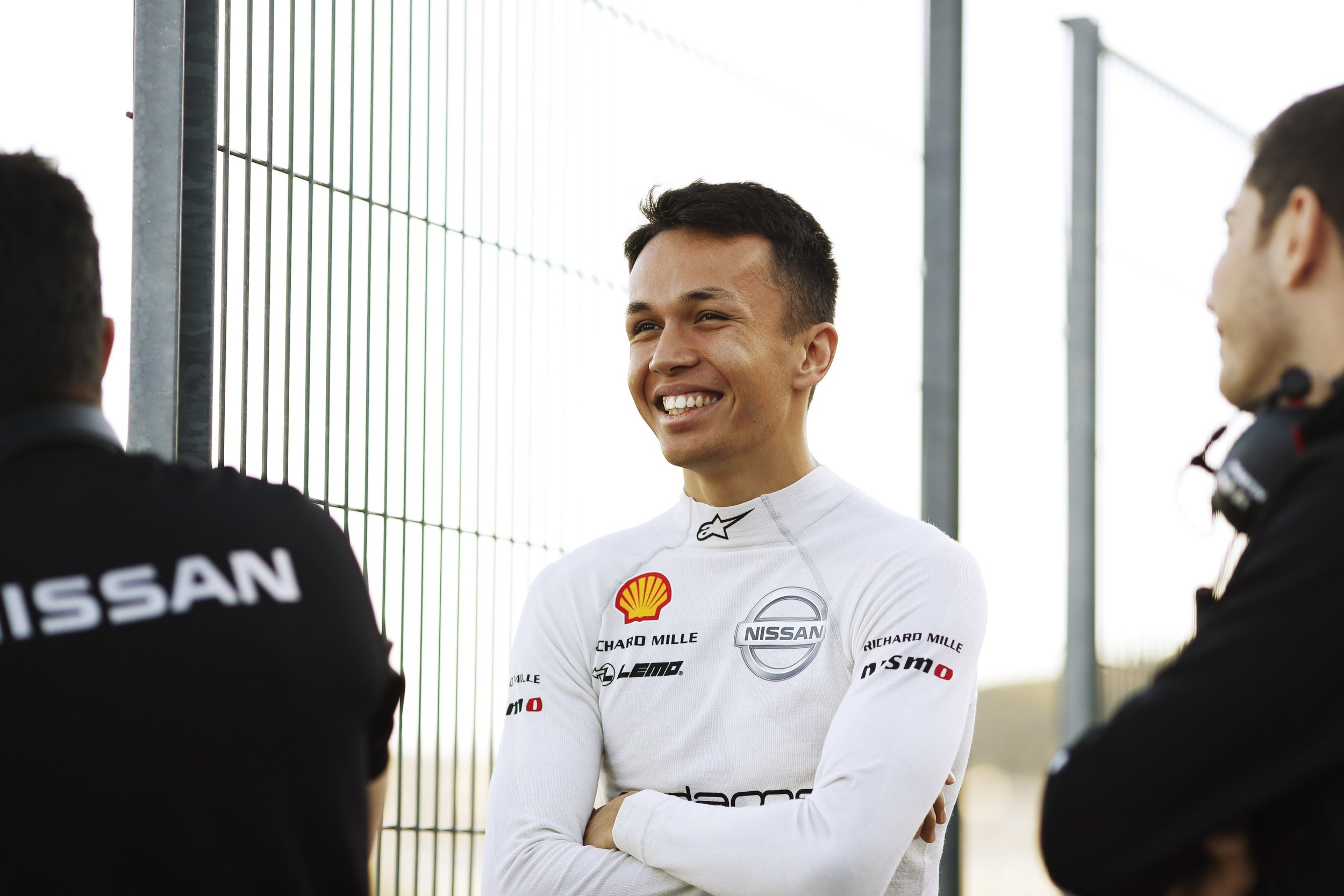What's Eating e.dams? Explaining the Decline of Nissan in Formula E
(copyright FIA Formula E)
Nissan e.dams come out of the Diriyah E-Prix with a lot of work to do. Their best finish on the opening weekend was 12th from a best grid position of 9th. It’s not what the manufacturers of formerly the best-selling electric car in the world wanted to see from the season-opener, and while in previous seasons it would be possible to plead bad luck, with the new qualifying format reducing the importance of a clean track to a high grid position, and track position being more about pure performance, Nissan are looking slow.
Not only that, unlike Porsche, who at least had Andre Lotterer wrestling his car into places it probably had no right to be, Nissan weren’t able to take advantage of a lightning start or a bit of elbows-out driving.
How did we get here? While there will be people insisting that single factors are to blame, it’s a bit more complicated than that. It would be remiss not to mention the impact of the death of DAMS founder Jean-Paul Driot in 2019 on the team, but by this stage, all of the key players in the Nissan e.dams operation are fully settled.
Diving into the statistics, it’s pretty easy to compare performance year-on-year, even with the caveat that the 2019-20 season was shortened to 11 races, with six of those taking place at the end of that season in Berlin, making that an outlier.
(stats: Motorsport Stats)
In the first season of the Gen2 cars, Nissan e.dams looked phenomenal in qualifying, but were unable to convert that one-lap speed into consistent race performances. Sebastien Buemi scored the single victory in New York, which was arguably less than the team deserved given the amazing superpole laps the asymmetric twin-motor powertrain was able to provide to its drivers.
Buemi’s most recent win was in New York 2018-19 (copyright FIA Formula E)
Buemi’s 2018-19 season, and subsequent seasons, look like this:
(stats: Motorsport Stats)
Buemi could be happy with the progress shown in that season, given that it meant he finished second in a chaotic title race where Jean-Eric Vergne frequently looked like the main contender even while he, and others, made it interesting by shooting him in the foot in the first six races. Still, it could be said that had Buemi made hay in those early races, Vergne would have found him too difficult to catch in the closing races of the campaign.
Alex Albon at Valencia testing 2018 (copyright FIA Formula E)
That season, Oliver Rowland took 71 points, finishing 10th in the championship, with two pole positions and two podium finishes, his average finish being 9.2. It has become something of a meme that Rowland involves himself in combat as readily as a 3am Cardiff chip-shop customer, but that season we can give him a pass, given that he had only raced once prior in Formula E, and was the no-expectations replacement for Alex Albon who had departed for Formula One in the middle of testing.
(stats: Motorsport Stats)
Buemi had done almost all of the pre-season running in autumn 2018, and it’s reasonable to wonder how far ahead Nissan might have been had they had two drivers running every day in Valencia 2018.
The 2019-20 season involved the rush-job redesign of Nissan’s powertrain, after Formula E’s teams voted by a majority to outlaw the twin motor, on the grounds supposedly that it could be used as a kind of flywheel, though in reality there was also the political complication of all teams wanting the category to avoid an arms race. There were probably a few boardrooms who were also sweating over their teams not having exploited the loophole that Nissan had found.
Nissan knuckled down and, without public complaint, produced a perfectly decent 2019-20 single-motor powertrain, but they couched all media interviews going into that season with the proviso that they had been forced to do far more substantial redesign work than any other team, meaning they were not able to focus on R&D.
The team, amazingly, improved on its Teams’ Championship position in 2019-20, moving from fourth the previous year to second. That points tally, though, obscured the rise of Mercedes through that season, Venturi’s inability at the time to take proper advantage of Mercedes power, Audi having a poor season, and Porsche not regularly troubling the frontrunners as they felt their way in. All of those teams have since found major improvements where Nissan e.dams have not.
Rowland enjoyed some excellent weekends with Nissan (copyright FIA Formula E)
While Buemi had carried the team the previous season, and had a car under him which he had tested solo, giving him an advantage, in 2019-20 Rowland had had equal time in the car, and while he took one podium to the more consistent Buemi’s four, it was Rowland who took the win in the Berlin “super-weekend”.
Move forward to 2020-21, and it seemed like neither Buemi nor Rowland could get a tune out of the Nissan e.dams package, although Rowland coped much better with what he had, dragging two podiums and a pole position, plus 77 points, out of an average finish of 9.42 and an average grid position of 7.93.
The question, then, is whether Rowland excelled sporadically in substandard equipment, or Buemi sufferend a major loss of form. The results speak of a combination of the two. Buemi suffered very publicly in the car, with only 20 points on an average finish of 11.18 and an average grid position of 9.47.
Both Nissan and DS waited to introduce new powertrains for the final Gen2 homologation, although for different reasons. DS Techeetah felt, correctly as it turned out, that their old-spec powertrain would be good enough to get them through the early flyaway races, with the new one coming in time for Rome. Nissan, on the other hand, delayed theirs until Monaco due to COVID-related supply-chain issues, meaning Buemi and Rowland had to make the best out of hardware that had already been looking a bit behind-the-curve at the end of the 2019-20 season. When the powertrain arrived, it wasn’t the step forward any of the team had hoped for.
Rowland’s move out of Nissan at the end of 2020-21 was painted as being as much money-driven as a racing decision; an ambitious driver knowing his worth, and wanting to move to a team, Mahindra, which was more than happy to better his salary. It’s equally possible, though, that he saw the writing on the wall from the struggles of Nissan e.dams last season.
Lucas di Grassi reportedly had talks with the team when it was clear he would be leaving Audi, and while a Buemi-di Grassi partnership always seemed fanciful given their history, it’s equally true that the Brazilian knew that Venturi would give him the keys to the best powertrain.
The Nissans in formation in Diriyah (copyright FIA Formula E)
Nissan’s chances of pulling themselves out of this current tailspin depend on Buemi finding the old powerhouse of the 2018-19 season, and before that the Gen1 era, within himself, and proving he is still far more than a redoubtable endurance driver - or that he wants to be more than that, as he sees, increasingly, his successes coming solely from working with Toyota.
Our chance of measuring Buemi’s ability to arrest his own decline depends on Maximilian Günther’s own ability to get the most out of himself. Having mostly bettered Alexander Sims at BMW i.Andretti, Günther was shown up last year by Jake Dennis (who was not assumed initially by most people, including this author, to be more than a solid number-two driver).
The German driver looks a diminished figure from the man who took three victories for BMW. Nissan have, in effect, swapped Rowland, a streaky, accident-prone, but combative and fast driver, for a slightly younger streaky, accident-prone, but combative and fast driver, but one who needs to find his flow after a chastening season where he was dropped from a team he had once seemed indispensable for. Nissan e.dams need a reboot too, not least to justify having already committed to the Gen3 rules set.
Nissan e.dams has been on the slide for a year or more. Both of their drivers are natural talents who need to reboot their careers. How they achieve that will be tied in with the fortunes of their team.








